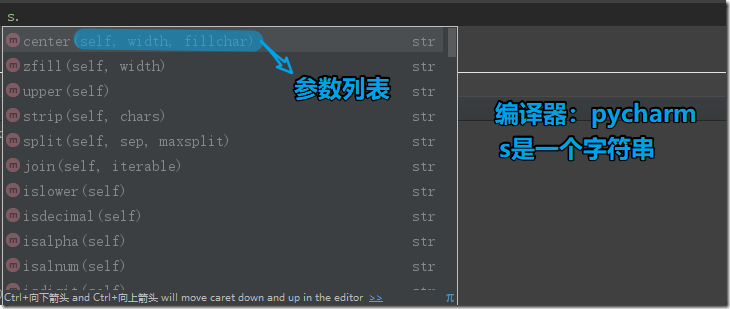相關: 字元串 常用函數 (更詳細參照函數庫或者使用編譯器時註意提示) 字元串格式化 原始字元串 列表 常用函數 列表生成式 字典 常用函數 集合 常用函數 附加: python的很多編譯... ...
相關:
- 字元串
- 常用函數 (更詳細參照函數庫或者使用編譯器時註意提示)
- 字元串格式化
- 原始字元串
- 列表
- 常用函數
- 列表生成式
- 字典
- 常用函數
- 集合
- 常用函數
附加:
python的很多編譯器提供了代碼補全功能,並且在填入參數時提供提示功能
字元串
1.常用函數:
字元串是不可變對象,字元串的方法都不會改變原字元串的數據
s=" hEllo world!\t " print("s.capitalize():",s.capitalize())#標題格式化 print("s.center(20,'-'):",s.center(20,'-'))#將字元串居中填充,填充元素為指定字元,總字元數為指定數量 print("s.count('l'):",s.count('l'))#統計某字元串出現次數 print("s.endswith:",s.endswith('d!'))#判斷字元串是否以d!結尾 print("s.find('o'):",s.find('o'))#查找指定元素,找到返回其索引 print("s.index('o'):",s.index('o'))#查找指定元素,找到返回其索引 sep='ABC' print("s.join(sep):",s.join(sep))#將原字元s插入到目標的每一個字元(或元素對象)中間 print("s.lower():",s.lower())#全轉成小寫 print("s.replace('l','j',1):",s.replace('l','j',1))#替換指定字元,最後一個是替換數量 print("s.split():",s.split())#切割字元串,切割字元為指定字元 print("s.strip():",s.strip())#去除左右空格元素,rstrip是只去除右邊,lstrip是只去除右邊 print("s.upper():",s.upper())#全轉大寫 """is系列: isdigit()-》是否是數字,isalnum()-》是否為字母或數字,isalpha()-》是否為英文字母 islower()-》是否全小寫, """
上訴代碼結果:
s.capitalize(): hello world! s.center(20,'-'): -- hEllo world! --- s.count('l'): 3 s.endswith: False s.find('o'): 5 s.index('o'): 5 s.join(sep): A hEllo world! B hEllo world! C s.lower(): hello world! s.replace('l','j',1): hEjlo world! s.split(): ['hEllo', 'world!'] s.strip(): hEllo world! s.upper(): HELLO WORLD!
2.字元串格式化:
python 字元串格式化--這個好像參數給的好全
>>> s="%d is 250" >>> s%250 '250 is 250' >>> b = "%(name)+10s————————%(age)-10d————————"%{'name':'xx','age':20} >>> print(b) xx————————20 ———————— >>> s="{:d} is a 250" >>> s.format(250) '250 is a 250' >>> a1 = "numbers: {:b},{:o},{:d},{:x},{:X}, {:%},{:c}".format(15, 15, 15, 15, 15, 15.87623,65) >>> print(a1) numbers: 1111,17,15,f,F, 1587.623000%,A >>> s="{} {} 250" >>> s.format(250,"500-250") '250 500-250 250' >>> s.format(250,"500-250") '250 500-250 250'
3.原始字元串:
起因:為了避免過多使用\來轉義,當字元串格式為 r"字元串" 時 裡面的字元全部當成字元,如\n不再當初換行
>>> print("a\tb") a b >>> print(r"a\tb") a\tb
但字元串無法處理,如果結尾是一個 \ :
>>> print(r"c:\a\b") c:\a\b >>> print(r"c:\a\b\") SyntaxError: EOL while scanning string literal >>> print(r"c:\a\b\\") c:\a\b\\ >>> print(r"c:\a\b"+"\\") c:\a\b\
這樣的情況最好使用字元串拼接來處理。
列表
1.常用函數:
print("查".center(20,'-')) list_find=['apple','banana','pen',1,2,3] #查找指定元素的下標 print(list_find.index('apple')) #查找某元素存在的數量 print(list_find.count("apple")) print("增".center(20,'-')) list_add=['apple','banana'] #追加元素到末尾 list_add.append("哈密瓜") print(list_add) #插入元素到指定位置 list_add.insert(0,"蘋果") print(list_add) print("刪".center(20,'-')) list_del=[1,2,3,4,5,6,7,8,9] #從列表中取出元素(刪除式取出),pop可以填參數,參數為刪除元素的下標 list_del.pop() print(list_del) #刪除指定元素名的元素 list_del.remove(4) print(list_del) #刪除對應元素空間 del list_del[0] print(list_del) print("其他".center(20,'-')) list_test4=['a','b','d','c'] list_test5=[1,2,3,4] #擴展列表 list_test5.extend(list_test4) print(list_test5) #對列表進行排序 list_test4.sort() print(list_test4)#註:py3無法對元素類型不同的進行排序 #反轉列表 list_test5.reverse() print(list_test5)
上述代碼運行結果:
---------查---------- 0 1 ---------增---------- ['apple', 'banana', '哈密瓜'] ['蘋果', 'apple', 'banana', '哈密瓜'] ---------刪---------- [1, 2, 3, 4, 5, 6, 7, 8] [1, 2, 3, 5, 6, 7, 8] [2, 3, 5, 6, 7, 8] ---------其他--------- [1, 2, 3, 4, 'a', 'b', 'd', 'c'] ['a', 'b', 'c', 'd'] ['c', 'd', 'b', 'a', 4, 3, 2, 1]
2.列表生成式:
#exp = 表達式 # 過程:1.迭代iterable中的每個元素; # 2.每次迭代都先把結果賦值給iter_var,然後通過exp得到一個新的計算值; #3. 最後把所有通過exp得到的計算值以一個新列表的形式返回。 #[exp for iter_var in iterable] print("1.[exp for iter_var in iterable]") list1=[i for i in range(10)] print(list1) list2=[i*i for i in range(10,20)] print(list2) print("\n") #[exp for iter_var in iterable if_exp] print("2.[exp for iter_var in iterable if_exp]") list3=[i for i in range(10) if i%2==0] print(list3) print("\n") #[exp for iter_var_A in iterable_A for iter_var_B in iterable_B] print("3.[exp for iter_var_A in iterable_A for iter_var_B in iterable_B]") list4=[x*y for x in range(5) for y in range(5)] print(list4) print("\n")
上述代碼運行結果:
1.[exp for iter_var in iterable] [0, 1, 2, 3, 4, 5, 6, 7, 8, 9] [100, 121, 144, 169, 196, 225, 256, 289, 324, 361] 2.[exp for iter_var in iterable if_exp] [0, 2, 4, 6, 8] 3.[exp for iter_var_A in iterable_A for iter_var_B in iterable_B] [0, 0, 0, 0, 0, 0, 1, 2, 3, 4, 0, 2, 4, 6, 8, 0, 3, 6, 9, 12, 0, 4, 8, 12, 16]
字典
1.常用函數:
d1={1:"蘋果","雪碧":"雪梨"}
d1.clear()#清空字典
print(d1)
d1={1:"蘋果","雪碧":"雪梨"}
print(d1.get(1))#獲取字典的指定鍵的結果
print(d1.get(3))#如果獲取不存在的鍵,返回None
print(d1.items())#獲取字典的所有鍵值對
print(d1.keys())#獲取字典的鍵
print(d1.values())#獲取字典的值
print(d1.pop(1))#取出指定下標結果
print(d1.popitem())#不需索引的彈出結果
print(d1)
d1={1:"蘋果","雪碧":"雪梨"}
d1.update({1:'apple',3:'pen'})#更新結果,同鍵名更新,新鍵名則添加結果
print(d1)
上述代碼運行結果:
{} 蘋果 None dict_items([(1, '蘋果'), ('雪碧', '雪梨')]) dict_keys([1, '雪碧']) dict_values(['蘋果', '雪梨']) 蘋果 ('雪碧', '雪梨') {} {1: 'apple', '雪碧': '雪梨', 3: 'pen'}
集合
1.常用函數:
s1=set(['a','b','c']) print(s1.pop())#隨機刪除集合中的某個元素,取到元素後返回元素的值 print(s1) s3={'a','d'} s1.update(s3)#更新 print(s1) s1.add('f')#增加元素 print(s1) s1.clear()#清空 s1=set(['a','b','c','f']) print(s1) s1.remove('a')#刪除目標元素,但集合中如無元素,會報錯 print(s1) s1.discard('g')#如果集合中無元素,不報錯;有元素,就刪除 print(s1) b={'a','b','g'} print("s1.difference(b)") print(s1.difference(b))# 取集合s中有,b中沒有的元素,並返回由此元素組成的集合 print("s1.interscetion(b)") print(s1.intersection(b))#交集,兩s和b中的交集,返回s,b中都存在的元素組成的集合 print("s1.issubset(b)") print(s1.issubset(b))#判斷s是否是b的子集 print("s1.issuperset(b)") print(s1.issuperset(b)) #判斷s是否是b的父集 print("s1.symmetric_difference(b)") print(s1.symmetric_difference(b)) #取差集,並創建一個新的集合 print("s1.union(b)") print(s1.union(b)) #並集 print("symmetric_difference_update") print(s1) s1.symmetric_difference_update(b)#無返回值 print(s1) """ xxxx_update的會覆蓋s1的值,如: s1.symmetric_difference_update() 得出symmetric_difference的結果後會覆蓋s1的值 """
上述代碼結果:
a {'c', 'b'} {'c', 'b', 'd', 'a'} {'c', 'b', 'd', 'f', 'a'} {'a', 'c', 'b', 'f'} {'c', 'b', 'f'} {'c', 'b', 'f'} s1.difference(b) {'c', 'f'} s1.interscetion(b) {'b'} s1.issubset(b) False s1.issuperset(b) False s1.symmetric_difference(b) {'a', 'g', 'c', 'f'} s1.union(b) {'g', 'c', 'b', 'f', 'a'} symmetric_difference_update {'c', 'b', 'f'} None {'g', 'c', 'f', 'a'}




